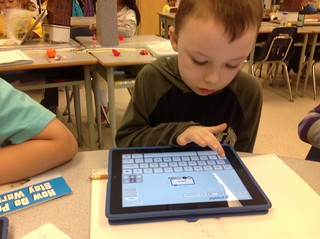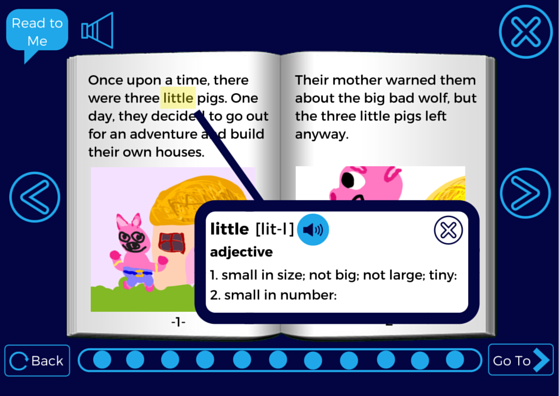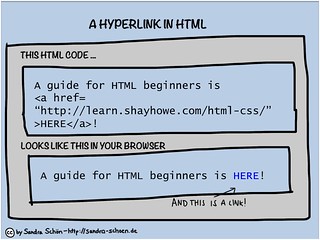
Graphic organizers are great tools students can to use to monitor their reading and comprehension of informational texts. Traditionally, teachers have created paper-based templates for students to use to organize their thinking around text. In a transliterate society, there are a number of web-based concept mapping tools and apps that teachers can employ in their classrooms to help support comprehension of informational text. Read the rest of this entry…
none

During the development of a literate society, literacy practices were very linear in nature. Consider a traditional piece of literature, like a book. It has a cover with the title and author. When we address these elements, we begin by decoding letters and words starting in the upper left and moving to the right across the first line to develop meaning and comprehend printed text. We then open the book, turn the page and then again begin to read for meaning making starting in the upper left, moving across to the right and then down to the next line. This repetitive process reflects the literacy practices most of us have participated in since birth. Read the rest of this entry…
none

In their most basic form, children’s ebooks are computer files that act much like a book. They have traditional conventions like a title, pages, and chapters. However, they also can contain illustrations and hotspots that provide a navigation mechanism for the reader. A deeper look at children’s ebooks reveals a more complex form, a type of software that includes animations, sounds, videos, and a read-aloud function. Read the rest of this entry…
none

Literacy is no longer confined to a standard print format. There is an increasing integration and adoption of digital texts and ebooks in school libraries and classrooms across the United States. Compared to their print counterparts, ebooks are portable, facilitating the easy transport of sizable libraries with little physical effort. The mobility of ebooks allows them to be used in any place at any time via handheld or mobile devices.
Ebooks for young children are like storybooks we know and love in some ways. While features of ebooks mirror those we see in traditional children’s literature, ebooks add new, digital features. These digital additions to print are different in a manner that is profoundly changing the storybook as a piece of early literacy learning. As a result, ebooks can be used to develop transliterate practices in the classroom that address academic and cognitive diversity in learners. Read the rest of this entry…
none

The author Donald J. Sobol first published his adventures of boy super sleuth “Encyclopedia” Brown in 1963. All 29 books in this popular series presented the reader with a set of short mysteries, each including factual disparities somewhere within. Young readers were encouraged to read the text closely to try to identify the “slip-up” that breaks the case and then turn to the “Answers” section in the back of the book to verify their finding.
An important part of writing in digital spaces is the use of “hyperlinks.” In their most basic form, a “link,” or hyperlink is word, phrase or image on a Web page that instructs a computer to move to another relevant Web page. Much like Sobol’s “Answers” section linked readers to the facts that solved each case, hyperlinked writing provides links that are pertinent to a piece of writing on the web and help to strengthen the writing by providing direct access back to source documents and related materials for the writer’s audience. Read the rest of this entry…
none

Transliteracy is a concept that captures the field of literacy and describes language arts as more than a function of foundational skills, such as reading and writing, but also encompasses the ability to communicate across traditional and emerging platforms (Thomas, S. et. al., 2007). Simply put, transliteracy is the understanding of traditional literacy components alongside the nuances that living in a touchscreen world brings. Transliteracy puts aside the differences between traditional and emerging literacies to focus on the interconnected path of all literacies and the role they play in developing a literate member of society. Students need to become fluent, not only in their reading and writing practice, but also in the digital skills that are put to regular use in the world around them.
Reading and writing are at the core of transliteracy, as we interact with both traditional and digital print in our daily lives. Whether we are flipping through the pages of our favorite paperback or checking the weather on our smartphone, foundational reading skills (letter knowledge, sounds, and word reading) and meaning- based skills (comprehension, conceptual knowledge, and vocabulary) play an integral role. However, new skills, such as recognizing icons, setting up preferences, mastering multi-tap and swipe gestures, all play a pivotal role becoming a transliterate individual. Read the rest of this entry…
none

This post was brought upon by the needs that the #UAEdTech learning community have expressed, is responsive and reflective in nature and a model of the type of transparent learning that the course instructors are asking you to engage in throughout the semester. It is also a model of the type of reflection, scaffolding and re-teaching that you will need to provide to your future students in your future classroom.
Over this past weekend, I received multiple emails regarding the Week 2 grading for Assignment 1.0 Networked Professional Learning. All of the emails contained some variation of a similar theme, “I just saw my Week 2 grade and I am just wondering where I lost points?” As I reflected on the questions being asked and thought about my response, I felt it would be best to address them in an open manner for the benefit of the entire #UAEdTech learning community.
I understand that the format of Assignment 1.0 may be a bit new and different from the other experiences that you have had in school to date. I also understand that it will take some time to get use to this style of learning. The points and feedback you have received to date reflect that you are learning and show room for growth. This is perfectly normal. If you’re a points person (I’m clearly not and firmly believe that we can assess learning with a variety of data beyond just statistics), the total points this week actually account for a mere 7% of the total points you can earn for just this assignment during the semester.
Do not look at the percentage you received on this 1/14th of Assignment 1.0 as a failure. It is certainly far from that. If you have to use the word FAIL, I hope you look at it as your First Attempt In Learning. With this lens, you will see that you have 13 more weeks to show your learning and growth as a Networked Professional Learner. The points for the Week 2 assignment simply establish a baseline of your understanding. While your baseline may be lower than where you would like it, a review of the rubric will probably tell you that the grade you received for Week 2 falls within the Satisfactory or higher range, so there is no need for alarm.
A few things to think about as we forge on through the semester. I think they’ll be helpful for you. Read the rest of this entry…
none
Spring 2015 semester is off and running at The University of Akron and the undergraduate Educational Technology course I am co-facilitating with Dr. Gary Holliday and Ms. Christine Dreher has been holding course orientation sessions all week. The course has about 125 students enrolled in it and we transitioning it from a traditional face-to-face lecture style course to a blended offering. As part of our course orientation, students are beginning to explore collaborative authoring by using Google Presentation to create individual BIO Poems to introduce themselves to their classmates and instructors. Meet our class!
none
2014 OSBA Capital Conference
Session Handout
It’s About Learning, Not Shiny Tech Tools
Tuesday, November 11, 2014 | 2:00 PM
Districts are investing lots of money in digital technologies. But if it’s about the learning, not the tools, what does that mean for students? What does it mean for teachers and administrators? What does it mean for the role of the board? This highly-interactive discussion will focus on student agency and empowerment, global connection and collaboration, and deeper, more cognitively-complex thinking tasks. Within those areas, what should board members be looking for? What questions should they be asking? How can they help support innovative efforts? We’ll hit all of this and more.
none
2014 OSBA Capital Conference
Session Handout
Modernizing Education for Student Success
Monday, November 10, 2014 | 9:00 AM
In this day and age, it feels like education is not in the hands of the true stakeholders: the students. Let’s discuss ways as educators, administrators, school board members, etc. that we can get education back to where it belongs. We will discuss ways that we can move away from the Industrial Age of education and take education and modernize it for our the benefit of our students and communities.
none







